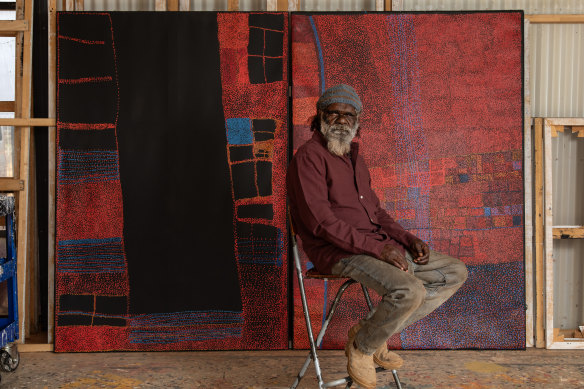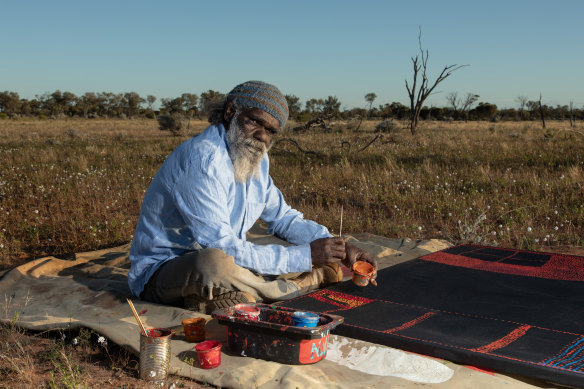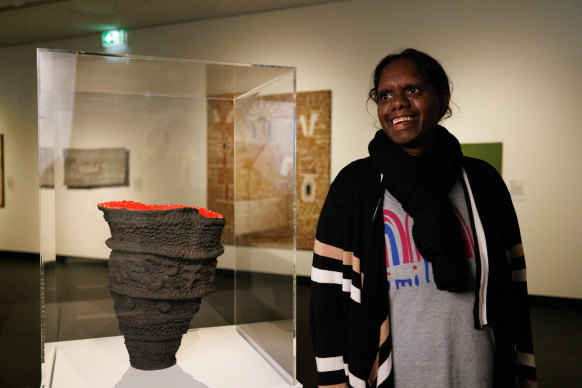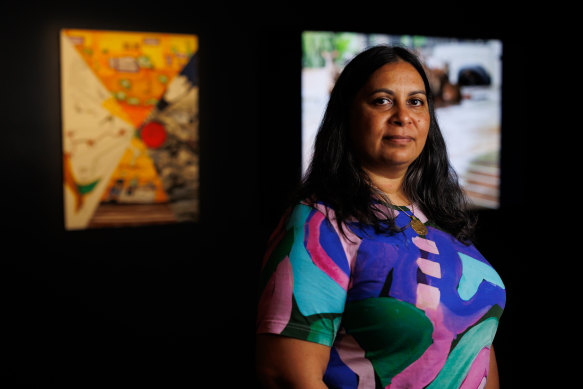He first met the outside world at 21. Now he’s won one of Australia’s richest arts prizes
By Helen Pitt
Pitjantjatjara artist Noli Rictor, whose family lived in Western Australia’s Great Victoria Desert and didn’t have any contact with the outside world until 1986, has scooped the nation’s richest and most prestigious Indigenous art competition.
Rictor, winner of the $100,000 National Aboriginal and Torres Strait Islander Art Awards, announced in Darwin on Friday, is believed to be the youngest “first contact” Aboriginal person in Australia, having survived as a traditional hunter-gatherer in the desert until the age of 21 with only his immediate family until relatives tracked them down.
His winning artwork, Kamanti, depicts the Wati Kutjara Tjukurpa (Two Men Creation Line), an epic narrative that follows the journey of father and son water serpents across their traditional homelands.

Noli Rictor, winner of the 2024 Telstra National Aboriginal and Torres Strait Islander Art Awards, with his work.Credit: Philip Gostelow
Rictor, who lives in Tjuntjuntjara in the 55,000-square-kilometre Spinifex Lands, believed to be the remotest Aboriginal community in Australia, drove 25 hours to Alice Springs to fly to Darwin to accept the award on Friday night.
“Winning has made me really happy and really proud of my country and practice,” he said on Friday through an interpreter from the Spinifex Arts Project.
“I intend to buy a new car with the money to go hunting for red kangaroo, and I also want to buy a TV, although I’m nervous about being on the TV for the first time now,” he said.
The Spinifex People started painting in 1997 to depict their homelands as a way of providing evidence of their continuous occupation, in the first mainland Australia Native Title determination after the 1992 Mabo case.
In that determination, the Rictor family footprints were found on the land that others had left 30 years prior due to the British nuclear testing taking place at Maralinga.
Rictor, 59, took up painting in 2004, after he saw the impact his two elder brothers, Ian and Mick, were having on his people, known as the Pila Nguru, which means “from the space between the dunes”.
“I saw how much change it can bring to the Pila Nguru,” said Rictor, who spent five weeks on his winning work which depicts the dunes, rocks and waterholes he knows intimately from his childhood hunting there.

Noli Rictor on country in Tjuntjuntjara.Credit: Philip Gostelow
“There’s water and plenty of food there when you know where to look for it,” he said of the homeland he has reimagined on canvas.
A highlight of the 41st NATSIAA competition, according to Adam Worrall, the director of the Museum and Art Gallery of the Northern Territory, was the significant participation of female artists this year, with 42 of the 72 finalists works by women.
“With 72 finalists that’s 72 different language groups and different countries, with artists telling stories about their country and the damage to people and country from climate change and extreme weather events like fires and flood,” said exhibition curator Rebekah Raymond.
Pitjantjatjara artist Josina Pumani won the Emerging Artist Award with Maralinga, a clay pot that tells the story of what happened to her family after the British nuclear tests from 1957 until 1963.

Artist Josina Pumani pictured with her work Maralinga.Credit: Charlie Bliss
“My uncle went blind and many of my family died from radiation sickness after the tests and there was no clinic to go to once they got sick from the smoke,” Pumani said.
“My dad told me people coughed a lot and had open wounds,” the 40-year-old Adelaide-based artist said.
“Maralinga hurt our lands and people and our story needs to be told ... we think about it all the time: Why did this happen to us?”
Pumani, whose mother, the late Ngupulya, and grandmother Kunmanara (Milatjari) Pumani were two of the founders of Mimili Maku Arts, started painting in 2009, but her 2024 entry was her first ceramic work.

Artist Natalie Davey won the Telstra Multimedia Award for River report.Credit: Charlie Bliss
Walmajarri and Bunuba artist Natalie Davey, won the Telstra Multimedia Award for River report, a 10-minute video which depicts the January 2023 floods at her Fitzroy Crossing home.
“I live about 50 metres from the banks of the Fitzroy River, and we have never had such a major flood event in 60,000 years, so I recorded it and drew maps of the affected areas,” she said.
“It was an emotional overload watching the water, which was magnificent and terrifying at the same time. I was in disbelief as I filmed and did so to double-check it was all real,” she said.
“It is the first time multimedia has been recognised in these awards which is great because it shows the evolving world of the artistic storyteller.”
The NATSIAA show is at Darwin’s Museum and Art Gallery of the Northern Territory (MAGNT) until January 27, 2025.
Helen Pitt travelled to Darwin courtesy of Tourism NT.
The Booklist is a weekly newsletter for book lovers from books editor Jason Steger. Get it every Friday.